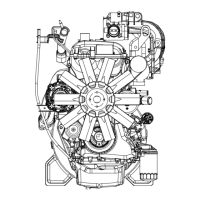DSG-423 ENGINE CONTROLS
08-24
DIAGNOSIS AND TESTING
Diagnostic Approach
Use the following step by step approach when
diagnosing an engine performance problem:
1. Verify the concern and determine if it is a deviation
from normal operation.
2. Once the concern has been verified, preliminary
checks can be done. Conduct a thorough visual
inspection, be alert for unusual sounds or odors, and
gather diagnostic trouble code (DTC) information.
3. If a diagnostic trouble code (DTC) is stored, follow
the designated DTC chart exactly to make an
effective repair.
4. If no DTC is stored, select the symptom from the
symptom charts and follow the suggestions to
complete the repair.
5. If no matching symptom is available, analyze the
complaint and develop a plan for diagnostics utilizing
the wiring diagrams, technical assistance and repair
history.
6. Some diagnostic charts contain diagnostic aids
which give additional information about a system. Be
sure to use all of the information that is available to
you.
GCP Diagnostic Overview
FORD Diagnostic Trouble Codes are set when the
FORD system GCP runs a diagnostic self-test and the
test fails. When a DTC is set, the FORD system GCP
will illuminate the Malfunction Indicator Lamp (MIL) on
the instrument panel and save the code in memory. The
FORD system GCP will continue to run the self-test
unless the DTC is an oxygen sensor lean, oxygen
sensor rich, or a GCP related DTC. If the system
continues to fail the test, the lamp will stay illuminated
and the DTC is current (ACTIVE). All DTC’s are stored
as historical faults until they are cleared. All DTC’s
except the GCP related DTC’s will automatically clear
from memory if the DTC does not reset within 50
consecutive engine run cycles.
While a Diagnostic Trouble Code is current for a sensor,
the FORD system GCP may assign a default limp home
value and use that value in its control algorithms. All of
the FORD system diagnostic self-tests run continuously
during normal engine operation.
The Diagnostic Trouble Codes can be read by using
either the Malfunction Indicator Lamp (MIL) or a Laptop
computer. Refer to Using a Laptop Computer to
Diagnose the FORD System and Using a Diagnostic
Jumper to Diagnose the FORD System, located in this
section. Diagnostic Trouble Codes can be cleared from
memory with a laptop computer or by turning the ignition
key to the OFF position and removing the FORD system
main power fuse (F3) for 15 seconds.
If more than one DTC is detected, begin with the lowest
number DTC and diagnose each problem to correction
unless directed to do otherwise by the fault tree. The
DTC’s are numbered in order of importance. Having
DTC 112 and DTC 122, both concerning the oxygen
sensor, is possible. By repairing DTC 112 first, the
problem causing the DTC 122 may also be corrected.
On-Board Diagnostics - GCP
The diagnostic tests and circuit charts are designed to
assist the technician to locate a faulty circuit or
component through a process of logical decisions. The
tests and charts are prepared with the requirement that
the engine functioned correctly at the time of assembly
and that there were not multiple faults present.
There is a continuous self-diagnosis on certain control
functions. This diagnostic capability is complimented by
the diagnostic procedures contained in this section. The
language for communicating the source of the
malfunction is a system of diagnostic trouble codes.
When a malfunction is detected by the Engine Control
Module (GCP), a Diagnostic Trouble Code (DTC) is set
and the Malfunction Indicator (MIL) lamp will be
illuminated (refer to MIL DTC Retrieval Procedure for
process description) -- Refer to“Diagnosis Using a
Personal Computer” on page 26 or Palm Pilot
Diagnosis, for information regarding performing GCP
and engine control system diagnosis.
Engine Control Module (GCP) Limp Home
Mode Strategy
The GCP has four settings for limp home mode.
Depending on what Diagnostic Trouble Code (DTC) is
set, one or more of the limp home modes will be in
effect.
The four limp home modes are as follows:
Power Derate 1
The actuator is limited to a maximum opening of 50%. If
“Power Derate 1” is active, it will remain active until the
active DTC goes away.
The following DTC’s will cause Power Derate 1 to take
affect:
• DTC 223: CHT/ECT higher than expected 1. (CHT/
ECT is greater than 240 °F).
• DTC 213: IAT higher than expected 1. (IAT is greater
than 200°F).
• DTC 253: Knock sensor open. (1.6L and 4.2L only)
• DTC 254: Excessive knock signal. (1.6L and 4.2L
only)
• DTC 511: FPP1 high voltage.
• DTC 512 FPP1 low voltage.
• DTC 521: FPP2 high voltage.
• DTC 522: FPP2 low voltage.
• DTC 545: IVS/Brake interlock failure.
Power Derate 2

